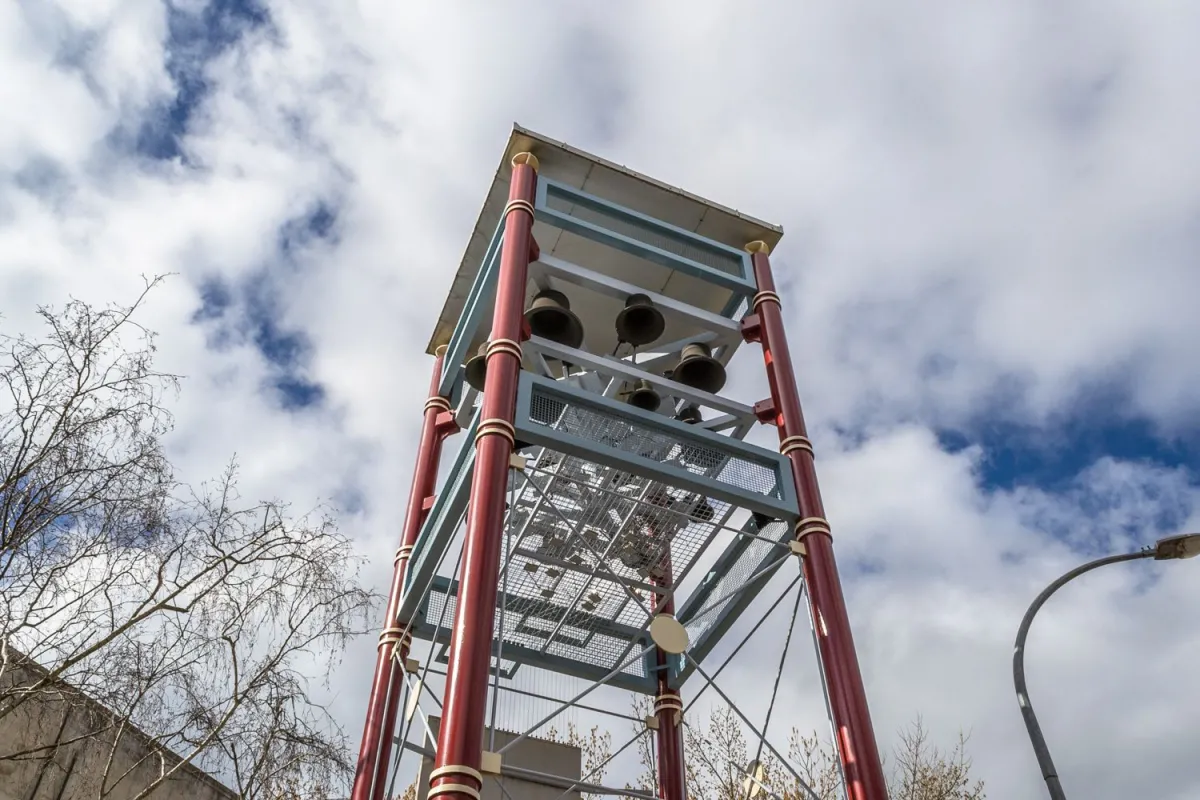Ballarat's fascinating Carillon, more accurately described as a chime, stands on display on the corner of Armstrong Street and Bath Lane.
This gorgeous set of 19th century bells are suspended within a modern tower, and are chimed by a mechanism housed in a display building below.
The carillon was purchased in 1869, at the same time the clock and Alfred Bells were being acquired for the Town Hall, and was relocated to be displayed at the present site in 1988.
This Bicentenary Project was funded by the City of Ballaarat, the combined Rotary Clubs of Ballarat and the Ballarat Bicentenary Committee.
The following information is provided on signs within the display building:
Operation of the Carillon
The operation of the carillon is similar to many toy mechanically operated musical devices although on a different scale.
The drum revolves at a speed of one revolution per 1 min. 18 sec. and is powered by an electric motor (originally it was powered by a large lead weight).
The pegs lift the lever and a system of wires raise the clapper. When the lever drops off the end of the peg the clapper falling under its own weight strikes the bell.
Different tunes are played by the cam located on the left side of the drum moving the levers sideways to engage a new set of pegs.
The Ballarat "Carillon"
Just how Ballarat came to acquire the Carillon (which more properly should be described as a "chime" is not known, but it was apparently purchased in 1869 at the time the Clock and the Alfred Bells were being obtained for the tower of the new Town Hall then under construction.
It is recorded in the Mayors Report of 1872/1873 that
"the Carillons have been received and erected and are now going regularly. The effect of the sound of the carillons have not realised expectations and it is in contemplation to try them in a different situation, as their present position is that selected be the manufacturers."
The problem of the sound continued for the next hundred years. Various different locations were tried over that period, including the top of the tower, the flat deck beside the tower, and even inside the building.
The mechanism was supplied by Moore and Sons, London, and the 15 bells by Mears and Stainbank (now the Whitechapel Foundry), London.
It is the oldest chime in Australia and, as a chime, the only one not located in a church.
The carillon as meant to be actuated by the tower clock and was geared to play four times during the day. The timber barrel has a different tune for each day of the week. Those tunes are:
- Sunday - "Sun of My Soul"
- Monday - "Blue Bells of Scotland"
- Tuesday - "Home Sweet Home"
- Wednesday - "Merry Bells of England"
- Thursday - "Swiss Air"
- Friday "Rule Britannia"
- Saturday - "Caller Herrin"
Although the Whitechapel Foundry supplied 15 bells, there were, until 1982, 16 bells - the extra bell having been cast by Horwood of Castlemaine. This extra bell has always been a conundrum, as it was not required in the playing of the seven tunes.
Legend has it that it as cast to replace a bell given away by a hallkeeper to a church but, in any case, its purpose has never been established.
One explanation of the extra bell may well lie in the fact that at the time Moore and Sons ordered the bells for the mechanism, they were also engaged in manufacturing a similar set of chimes for a London Market which was to have 16 bells, and that in the shipment, the two sets were mixed up, 15 bells with a 16 bell mechanism coming to Ballarat, and then to rectify the absence of the 16th bell, a replacement was ordered from Castlemaine.
An inspection of both the bells and the mechanism by a representative off Whitechapel Foundry in 1978 provided the advice that the solution to the century old problem of sound was to have the bells melted down, assayed, and recast.
The opportunity to have that done occurred in 1983 when the Alfred Bells from the Town Hall tower were returned for refurbishing to Whitechapel where they were originally cast in 1869. This work was carried out by the generous benefaction of the Estate of W. R. Bones.
The Carillon now sounds again, after more than a century of almost silence, as a Bicentenary project funded by the City of Ballaarat, the combined Rotary Clubs of Ballarat and the Ballarat Bicentenary Committee.


